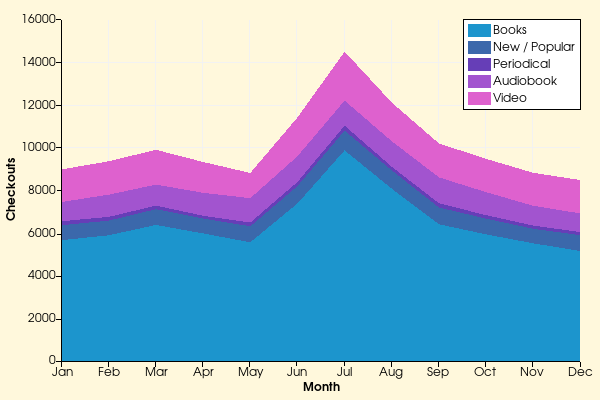StackedPlot
Repository source: StackedPlot
Question
If you have a question about this example, please use the VTK Discourse Forum
Code¶
StackedPlot.cxx
#include <vtkAxis.h>
#include <vtkChartXY.h>
#include <vtkColorSeries.h>
#include <vtkContextView.h>
#include <vtkDoubleArray.h>
#include <vtkIntArray.h>
#include <vtkNamedColors.h>
#include <vtkNew.h>
#include <vtkPlotStacked.h>
#include <vtkRenderWindow.h>
#include <vtkRenderWindowInteractor.h>
#include <vtkRenderer.h>
#include <vtkStringArray.h>
#include <vtkTable.h>
namespace {
// Monthly checkout data.
std::string month_labels[] = {"Jan", "Feb", "Mar", "Apr", "May", "Jun",
"Jul", "Aug", "Sep", "Oct", "Nov", "Dec"};
constexpr int book[] = {5675, 5902, 6388, 5990, 5575, 7393,
9878, 8082, 6417, 5946, 5526, 5166};
constexpr int new_popular[] = {701, 687, 736, 696, 750, 814,
923, 860, 786, 735, 680, 741};
constexpr int periodical[] = {184, 176, 166, 131, 171, 191,
231, 166, 197, 162, 152, 143};
constexpr int audiobook[] = {903, 1038, 987, 1073, 1144, 1203,
1173, 1196, 1213, 1076, 926, 874};
constexpr int video[] = {1524, 1565, 1627, 1445, 1179, 1816,
2293, 1811, 1588, 1561, 1542, 1563};
} // namespace
//----------------------------------------------------------------------------
int main(int, char*[])
{
vtkNew<vtkNamedColors> colors;
// Set up a 2D scene, add an XY chart to it.
vtkNew<vtkContextView> view;
view->GetRenderer()->SetBackground(1.0, 1.0, 1.0);
view->GetRenderWindow()->SetSize(400, 300);
vtkNew<vtkChartXY> chart;
view->GetScene()->AddItem(chart);
// Create a table with some points in it...
vtkNew<vtkTable> table;
vtkNew<vtkStringArray> arrMonthLabel;
arrMonthLabel->SetNumberOfValues(12);
vtkNew<vtkDoubleArray> arrXTickPositions;
arrXTickPositions->SetNumberOfValues(12);
vtkNew<vtkIntArray> arrMonth;
arrMonth->SetName("Month");
table->AddColumn(arrMonth);
vtkNew<vtkIntArray> arrBook;
arrBook->SetName("Books");
table->AddColumn(arrBook);
vtkNew<vtkIntArray> arrNewPopularBook;
arrNewPopularBook->SetName("New / Popular");
table->AddColumn(arrNewPopularBook);
vtkNew<vtkIntArray> arrPeriodical;
arrPeriodical->SetName("Periodical");
table->AddColumn(arrPeriodical);
vtkNew<vtkIntArray> arrAudiobook;
arrAudiobook->SetName("Audiobook");
table->AddColumn(arrAudiobook);
vtkNew<vtkIntArray> arrVideo;
arrVideo->SetName("Video");
table->AddColumn(arrVideo);
table->SetNumberOfRows(12);
for (int i = 0; i < 12; i++)
{
arrMonthLabel->SetValue(i, month_labels[i]);
arrXTickPositions->SetValue(i, i);
arrBook->SetValue(i, book[i]);
arrNewPopularBook->SetValue(i, new_popular[i]);
arrPeriodical->SetValue(i, periodical[i]);
arrAudiobook->SetValue(i, audiobook[i]);
arrVideo->SetValue(i, video[i]);
}
// Set the Month Labels
chart->GetAxis(1)->SetCustomTickPositions(arrXTickPositions, arrMonthLabel);
chart->GetAxis(1)->SetMaximum(11);
chart->GetAxis(1)->SetRange(0, 11);
chart->GetAxis(1)->SetBehavior(vtkAxis::FIXED);
chart->GetAxis(1)->SetTitle("Month");
chart->SetShowLegend(true);
chart->GetAxis(0)->SetTitle("Checkouts");
// Add multiple line plots, setting the colors etc.
vtkPlotStacked* stack = 0;
// Books
stack = dynamic_cast<vtkPlotStacked*>(chart->AddPlot(vtkChart::STACKED));
stack->SetUseIndexForXSeries(true);
stack->SetInputData(table);
stack->SetInputArray(1, "Books");
stack->SetInputArray(2, "New / Popular");
stack->SetInputArray(3, "Periodical");
stack->SetInputArray(4, "Audiobook");
stack->SetInputArray(5, "Video");
vtkNew<vtkColorSeries> colorSeries;
colorSeries->SetColorScheme(vtkColorSeries::WILD_FLOWER);
stack->SetColorSeries(colorSeries);
// Finally render the scene and compare the image to a reference image.
view->GetRenderWindow()->SetMultiSamples(0);
view->GetRenderer()->SetBackground(colors->GetColor3d("Cornsilk").GetData());
view->GetRenderWindow()->SetSize(600, 400);
view->GetRenderWindow()->SetWindowName("StackedPlot");
view->GetRenderWindow()->Render();
view->GetInteractor()->Initialize();
view->GetInteractor()->Start();
return EXIT_SUCCESS;
}
CMakeLists.txt¶
cmake_minimum_required(VERSION 3.12 FATAL_ERROR)
project(StackedPlot)
find_package(VTK COMPONENTS
ChartsCore
CommonColor
CommonCore
CommonDataModel
InteractionStyle
RenderingContextOpenGL2
RenderingCore
RenderingFreeType
RenderingGL2PSOpenGL2
RenderingOpenGL2
ViewsContext2D
)
if (NOT VTK_FOUND)
message(FATAL_ERROR "StackedPlot: Unable to find the VTK build folder.")
endif()
# Prevent a "command line is too long" failure in Windows.
set(CMAKE_NINJA_FORCE_RESPONSE_FILE "ON" CACHE BOOL "Force Ninja to use response files.")
add_executable(StackedPlot MACOSX_BUNDLE StackedPlot.cxx )
target_link_libraries(StackedPlot PRIVATE ${VTK_LIBRARIES}
)
# vtk_module_autoinit is needed
vtk_module_autoinit(
TARGETS StackedPlot
MODULES ${VTK_LIBRARIES}
)
Download and Build StackedPlot¶
Click here to download StackedPlot and its CMakeLists.txt file. Once the tarball StackedPlot.tar has been downloaded and extracted,
cd StackedPlot/build
If VTK is installed:
cmake ..
If VTK is not installed but compiled on your system, you will need to specify the path to your VTK build:
cmake -DVTK_DIR:PATH=/home/me/vtk_build ..
Build the project:
make
and run it:
./StackedPlot
WINDOWS USERS
Be sure to add the VTK bin directory to your path. This will resolve the VTK dll's at run time.
